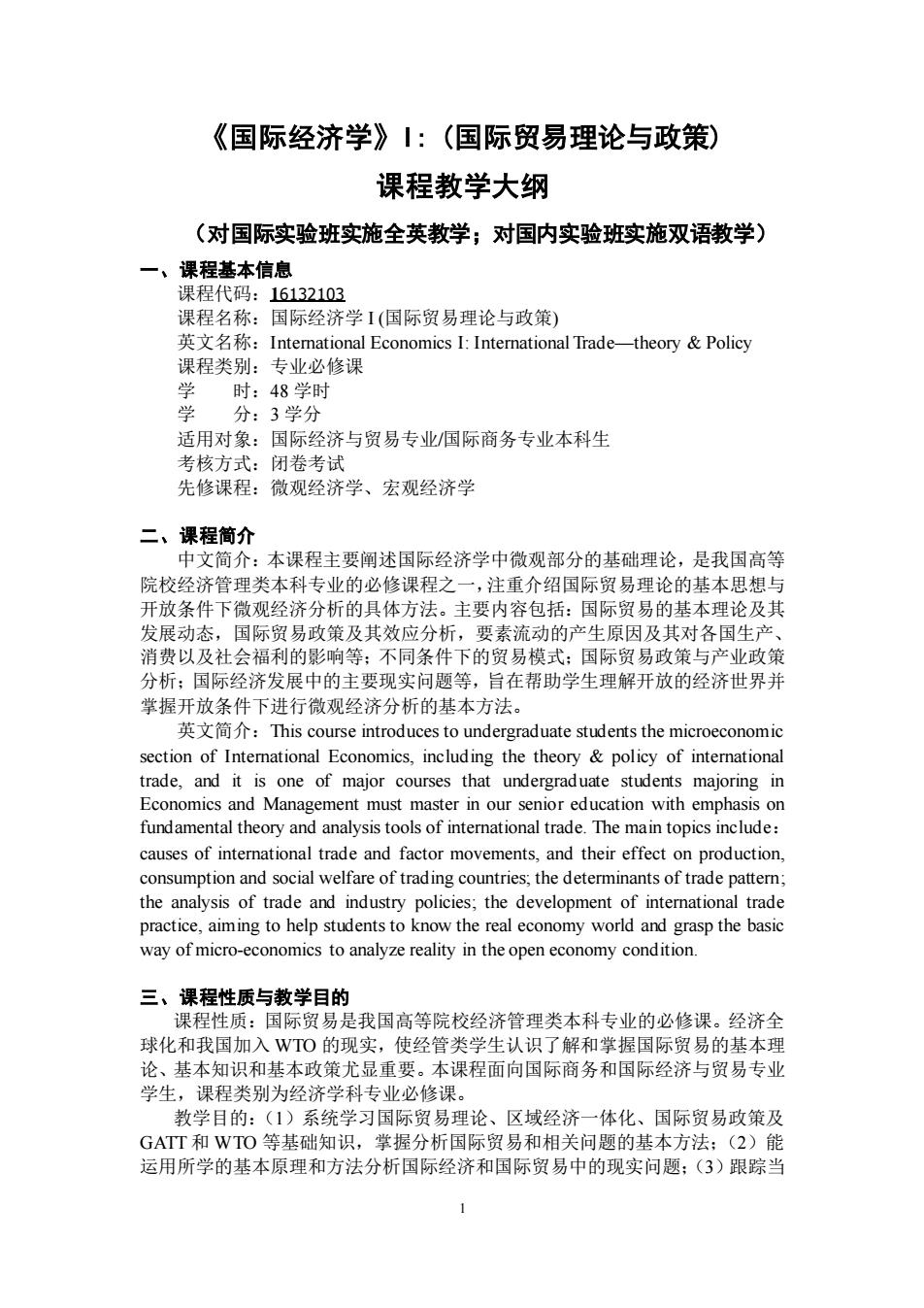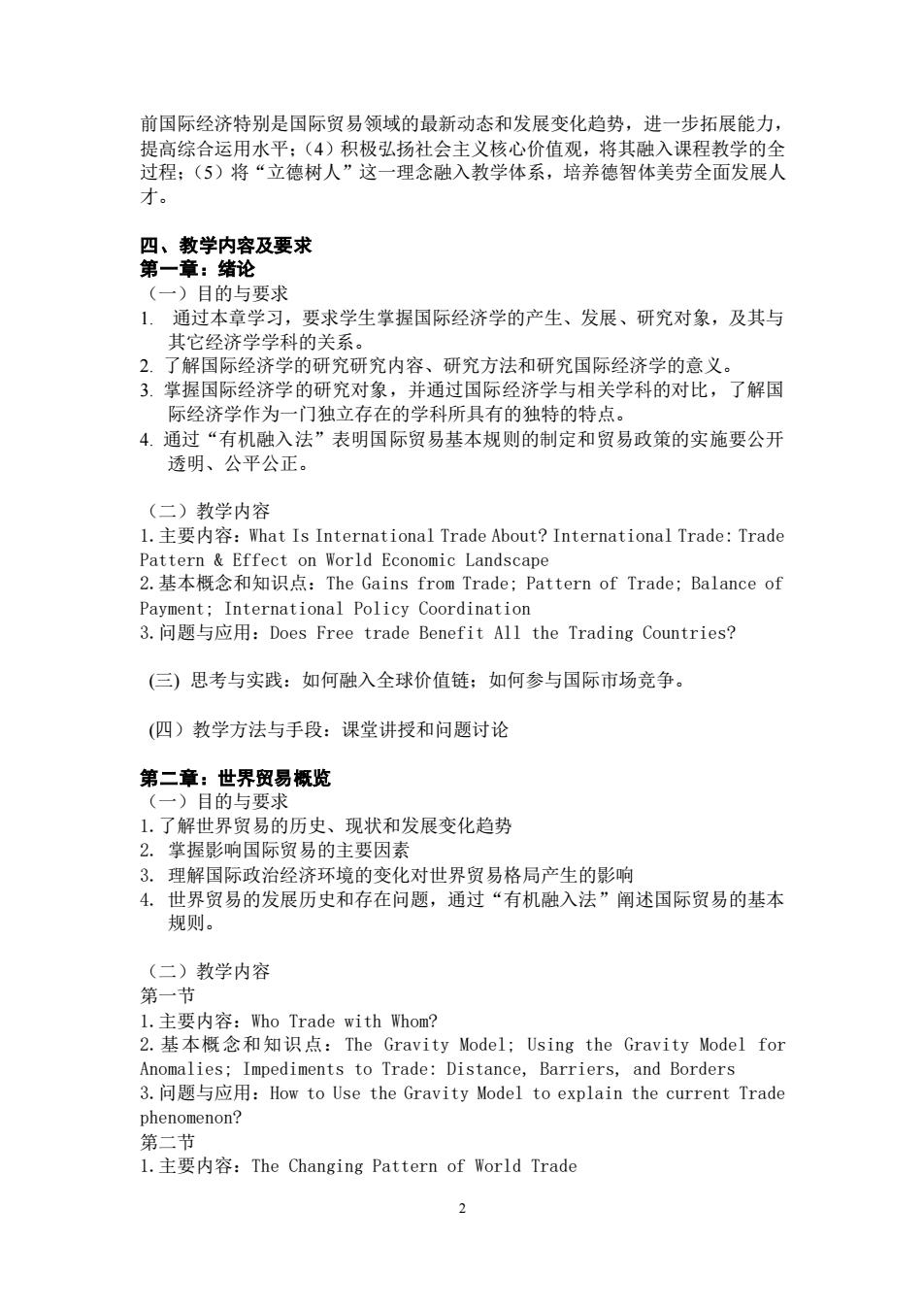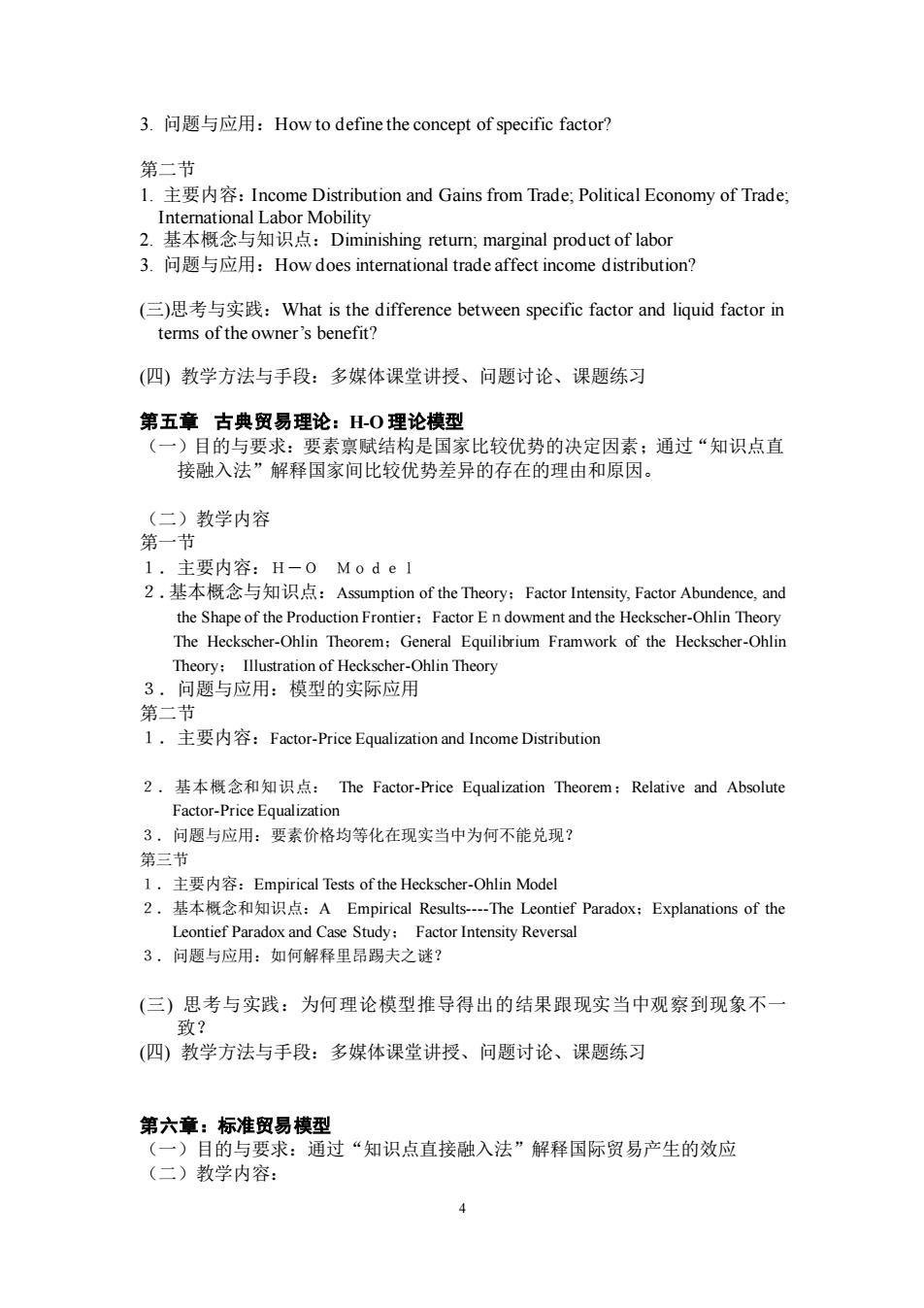
《国际经济学》:(国际贸易理论与政策) 课程教学大纲 (对国际实验班实施全英教学;对国内实验班实施双语教学) 一、课程基本信息 里程代码,16132103 课程名称:国际经济学1(国际贸易理论与政策) 英文名称:Intemational Economics I:International Trade-theory&Policy 课程类别:专业必修课 学 时:48学时 学分:3学分 适用对象:国际经济与贸易专业国际商务专业本科生 考核方式:闭卷考试 先修课程:微视经济学、宏观经济学 二、课程简介 中文简介:本课程主要阐述国际经济学中微观部分的基础理论,是我国高等 院校经济管理类本科专业的必 修课程之 ,注重介绍国际贸易理论的基本思想与 开放条件下微观经济分析的具体方法。主要内容包活:国际贸易的基本理论及其 发展动态,国际贸易政策及其效应分析,要素流动的产生原因及其对各国生产、 消费以及社会福利的影响等:不同条件下的贸易模式:国际贸易政策与产业政策 分析:国际经济发展中的主要现实问题等,旨在帮助学生理解开放的经济世界并 掌握开放条件下进行微观经济分析的基本方法。 '又i间介:This course introduces to undergraduate students the microeconomic section of Intemational Economics,including the theory policy of international irade,and it is one of major courses that undergraduate students majoring in and Ma ceht】 ter in our senk reducatio or ain topics include causes of international trade and factor movements.and their effect on production. consumption and social welfare of trading countries:the determinants of trade patter: the analysis of trade and industry policies:the development of international trade practice,aiming to help students to know the real economy world and grasp the basic way of micro-economics to analyze reality in the open economy conditior 三、课程性质与教学目的 课程性质:国际贸易是我国高等院校经济管理类本科专业的必修课。经济全 球化和我国加入WTO的现实,使经管类学生认识了解和掌握国际贸易的基本理 论、基本知识和基本改策广显重要。本课程面向国际商条和国际经济与留易专业 学生,课程类别为经济学科专业必修课 教学目的:(1)系统学习国际贸易理论、区域经济一体化、国际贸易政策及 GATT和WTO等基础知识,掌握分析国际贸易和相关问题的基本方法:(2)能 运用所学的基本原理和方法分析国际经济和国际贸易中的现实问题:(3)跟踪当
1 《国际经济学》I: (国际贸易理论与政策) 课程教学大纲 (对国际实验班实施全英教学;对国内实验班实施双语教学) 一、课程基本信息 课程代码:16132103 课程名称:国际经济学 I (国际贸易理论与政策) 英文名称:International Economics I: International Trade—theory & Policy 课程类别:专业必修课 学 时:48 学时 学 分:3 学分 适用对象:国际经济与贸易专业/国际商务专业本科生 考核方式:闭卷考试 先修课程:微观经济学、宏观经济学 二、课程简介 中文简介:本课程主要阐述国际经济学中微观部分的基础理论,是我国高等 院校经济管理类本科专业的必修课程之一,注重介绍国际贸易理论的基本思想与 开放条件下微观经济分析的具体方法。主要内容包括:国际贸易的基本理论及其 发展动态,国际贸易政策及其效应分析,要素流动的产生原因及其对各国生产、 消费以及社会福利的影响等;不同条件下的贸易模式;国际贸易政策与产业政策 分析;国际经济发展中的主要现实问题等,旨在帮助学生理解开放的经济世界并 掌握开放条件下进行微观经济分析的基本方法。 英文简介:This course introduces to undergraduate students the microeconomic section of International Economics, including the theory & policy of international trade, and it is one of major courses that undergraduate students majoring in Economics and Management must master in our senior education with emphasis on fundamental theory and analysis tools of international trade. The main topics include: causes of international trade and factor movements, and their effect on production, consumption and social welfare of trading countries; the determinants of trade pattern; the analysis of trade and industry policies; the development of international trade practice, aiming to help students to know the real economy world and grasp the basic way of micro-economics to analyze reality in the open economy condition. 三、课程性质与教学目的 课程性质:国际贸易是我国高等院校经济管理类本科专业的必修课。经济全 球化和我国加入 WTO 的现实,使经管类学生认识了解和掌握国际贸易的基本理 论、基本知识和基本政策尤显重要。本课程面向国际商务和国际经济与贸易专业 学生,课程类别为经济学科专业必修课。 教学目的:(1)系统学习国际贸易理论、区域经济一体化、国际贸易政策及 GATT 和 WTO 等基础知识,掌握分析国际贸易和相关问题的基本方法;(2)能 运用所学的基本原理和方法分析国际经济和国际贸易中的现实问题;(3)跟踪当

前国际经济特别是国际贸易领域的最新动态和发展变化趋势,进一步拓展能力, 提高综合运用水平:(4)积极弘扬社会主义核心价值观,将其融入课程教学的全 过程:(5)将“立德树人”这 一理念融入教学体系,培养德智体美劳全面发展人 才。 四、教学内容及要求 第一章:绪论 (一)目的与要求 1.通过本章学习,要求学生掌握国际经济学的产生、发展、研究对象,及其与 其它经济学学科的关系。 2.了解闲际经济学的研究研穷究内容、研究方法和研究闲际经济学的意义。 3.掌握国际经济学的研究对象,并通过国际经济学与相关学科的对比,了解国 际经济学作为一门独立存在的学科所具有的独特的特点。 4.通过 有机融入法”表明国际贸易基本规则的制定和贸易政策的实施要公开 透明、公平公正。 (二)教学内容 l.主要内容:What Is International Trade About?International Trade:Trade n World and 基不念不蜘点:The Gains o Tde:Pattorn of7ae:Bulance Payment:International policy Coordination 3.问题与应用:Does Free trade Benefit All the Trading Countries? (仁)思考与实践:如何融入全球价值链;如何参与国际市场竞争。 (四)教学方法与手段:课堂讲授和问题讨论 第二章:世界贸易概览 (一)目的与要求 掌握影响国际贸易的主要因素 3.理解国际政治经济环境的变化对世界贸易格局产生的影响 4.世界贸易的发展历史和存在问题,通过“有机融入法”闸述国际贸易的基本 规则。 (二)教学内容 第一节 l.主要内容:ho Trade with Whom? 2.基本概念和知识点:The Gravity Model:Using the Gravity Model for Anomalies:Impediments to Trade:Distance,Barriers,and Borders 3.问题与应用:How to Use the Gravity Model to explain the current Trade phenomenon? 第二节 l.主要内容:The Changing Pattern of World Trade
2 前国际经济特别是国际贸易领域的最新动态和发展变化趋势,进一步拓展能力, 提高综合运用水平;(4)积极弘扬社会主义核心价值观,将其融入课程教学的全 过程;(5)将“立德树人”这一理念融入教学体系,培养德智体美劳全面发展人 才。 四、教学内容及要求 第一章:绪论 (一)目的与要求 1. 通过本章学习,要求学生掌握国际经济学的产生、发展、研究对象,及其与 其它经济学学科的关系。 2. 了解国际经济学的研究研究内容、研究方法和研究国际经济学的意义。 3. 掌握国际经济学的研究对象,并通过国际经济学与相关学科的对比,了解国 际经济学作为一门独立存在的学科所具有的独特的特点。 4. 通过“有机融入法”表明国际贸易基本规则的制定和贸易政策的实施要公开 透明、公平公正。 (二)教学内容 1.主要内容:What Is International Trade About? International Trade: Trade Pattern & Effect on World Economic Landscape 2.基本概念和知识点:The Gains from Trade; Pattern of Trade; Balance of Payment; International Policy Coordination 3.问题与应用:Does Free trade Benefit All the Trading Countries? (三) 思考与实践:如何融入全球价值链;如何参与国际市场竞争。 (四)教学方法与手段:课堂讲授和问题讨论 第二章:世界贸易概览 (一)目的与要求 1.了解世界贸易的历史、现状和发展变化趋势 2. 掌握影响国际贸易的主要因素 3. 理解国际政治经济环境的变化对世界贸易格局产生的影响 4. 世界贸易的发展历史和存在问题,通过“有机融入法”阐述国际贸易的基本 规则。 (二)教学内容 第一节 1.主要内容:Who Trade with Whom? 2.基本概念和知识点:The Gravity Model; Using the Gravity Model for Anomalies; Impediments to Trade: Distance, Barriers, and Borders 3.问题与应用:How to Use the Gravity Model to explain the current Trade phenomenon? 第二节 1.主要内容:The Changing Pattern of World Trade

2.基本概念和知识点:Has the world gotten smaller'?hat do we trade? (三)思考与实践:How will the world economic landscape change in the near future due to complicated political reasons? (四)教学方法与手段:课堂讲授和问题讨论 第三章:古典贸易理论(绝对优势和比较优势理论) (一)目的与要求 1,本章作为国际贸易纯理论的重要组成部分,主要闸述了古老的重商主义,以 及对国际贸易理论仍然具有里程碑意义的绝对优势论、比较优势论和穆勒德 相互需求理论 通过本章学习要求学生掌握古典国际贸易理论的精髓,并学会用数学模型将 其表述出来。 3.掌握国际市场的客观规律,熟悉其运行规则。 4.通过“知识点直接融入法”解释自由贸易确保全球有限资源利用率达到帕累 杆品代。 L.主要内容:Absolute Advantage Theory;absolute advantage in practice;Adam Smith Model 2.基本概念和知识点:Concept of absolute advantage,.content&definition 3.问题与应用:How to measure the absolute advantage of a country? 第一背 1.主要内容 arative Advantage Theory:Comparative advantage in practice. hc R cardo N 2.基本概念和知识点:Concept of comparative advantage,content&definition 3.问题与应用:How to measure the comparative advantage of a country? (三)思考与实践:What is the relationship&difference between Absolute Advantage theory and Comparative Advantage theory? (四)教学方法与手段:课堂讲授、问题讨论、课题练习 第四章:特定要素模型和收入分配 (一)目的与要求:通过“知识点直接融入法”权衡经济效率和公平公正问题的 解决。 (二)教学内容 第一节 L.主要内容:Specific Factor Model;Intemational Trade in the Specific Model; 2.基本概念与知识点:production function;production possbility,specific factor. 3
3 2.基本概念和知识点:Has the world gotten smaller? What do we trade? Service Outsourcing. 3. 问题与应用:Do old rules still apply? (三)思考与实践:How will the world economic landscape change in the near future due to complicated political reasons? (四)教学方法与手段:课堂讲授和问题讨论 第三章:古典贸易理论(绝对优势和比较优势理论) (一)目的与要求 1. 本章作为国际贸易纯理论的重要组成部分,主要阐述了古老的重商主义,以 及对国际贸易理论仍然具有里程碑意义的绝对优势论、比较优势论和穆勒德 相互需求理论。 2. 通过本章学习要求学生掌握古典国际贸易理论的精髓,并学会用数学模型将 其表述出来。 3. 掌握国际市场的客观规律,熟悉其运行规则。 4. 通过“知识点直接融入法”解释自由贸易确保全球有限资源利用率达到帕累 托最优。 (二) 教学内容 第一节 1. 主要内容:Absolute Advantage Theory; absolute advantage in practice; Adam Smith Model 2. 基本概念和知识点:Concept of absolute advantage, content & definition 3. 问题与应用: How to measure the absolute advantage of a country? 第二节 1. 主要内容:Comparative Advantage Theory;Comparative advantage in practice; The Ricardo Model 2. 基本概念和知识点:Concept of comparative advantage, content & definition 3. 问题与应用:How to measure the comparative advantage of a country? (三)思考与实践:What is the relationship & difference between Absolute Advantage theory and Comparative Advantage theory? (四) 教学方法与手段:课堂讲授、问题讨论、课题练习 第四章:特定要素模型和收入分配 (一)目的与要求:通过“知识点直接融入法”权衡经济效率和公平公正问题的 解决。 (二)教学内容 第一节 1.主要内容:Specific Factor Model; International Trade in the Specific Model; 2. 基本概念与知识点: production function; production possibility; specific factor;

3.问题与应用:How to define the concept of specific factor? 第一节 1.主要内容:n s☑:学g 3.间题与u用:How does international trade affect income distribution? (三)思考与实践:What is the difference between specific factor and liquid factor in terms of the owner's benefit? (四)教学方法与手段:多媒体课堂讲授、问题讨论、课题练习 第五章古典贸易理论:H-0理论模型 (一)目的与要求:要素禀赋结构是国家比较优势的决定因素;通过“知识点直 接融入法”解释国家间比较优势差异的存在的理由和原因 (二)教学内容 第一节 1.主要内容:H-0Mode1 2.基本概念与知识点:Assumption of the Theory: Factor Intensity,Factor Abundence,and the Shape of the Production Frontier:Factor En dowment and the Heckscher-Ohlin Theory The Heckscher-Ohlin Theorem:General Equilibrium Framwork of the Heckscher-Ohlin Theory:Illustration of Heckscher-Ohlin Theory 3.问题与应用:模型的实际应用 第一节 1.主要内容:Factor-Price Equalization Distribution 2.基本概念和知识点:The Factor-Price Equalization Theorem:Relative and Absolute Factor-Price Equalization 3,问愿与应用:要素价格均等化在现实当中为何不能兑现? 第三节 .主要内容:Empirical Tests of the Heckscher-Ohlin Model 2.基本概念和知识点:A Empirical Results--The Leontief Paradox:Explanations of the Leontief Paradox and Case Study:Factor Intensity Reversal 3.问题与应用:如何解释里昂踢夫之谜? (三)思考与实践:为何理论模型推导得出的结果跟现实当中观察到现象不 (四)教学方法与手段:多媒体课堂讲授、问题讨论、课题练习 第六章:标准贸易模型 的与 求:通过“知识点直接融入法”解释国际贸易产生的效应 (二)教学内容
4 3. 问题与应用:How to define the concept of specific factor? 第二节 1. 主要内容:Income Distribution and Gains from Trade; Political Economy of Trade; International Labor Mobility 2. 基本概念与知识点:Diminishing return; marginal product of labor 3. 问题与应用:How does international trade affect income distribution? (三)思考与实践:What is the difference between specific factor and liquid factor in terms of the owner’s benefit? (四) 教学方法与手段:多媒体课堂讲授、问题讨论、课题练习 第五章 古典贸易理论:H-O 理论模型 (一)目的与要求:要素禀赋结构是国家比较优势的决定因素;通过“知识点直 接融入法”解释国家间比较优势差异的存在的理由和原因。 (二)教学内容 第一节 1.主要内容:H-O Model 2.基本概念与知识点:Assumption of the Theory;Factor Intensity, Factor Abundence, and the Shape of the Production Frontier;Factor Endowment and the Heckscher-Ohlin Theory The Heckscher-Ohlin Theorem;General Equilibrium Framwork of the Heckscher-Ohlin Theory; Illustration of Heckscher-Ohlin Theory 3.问题与应用:模型的实际应用 第二节 1.主要内容:Factor-Price Equalization and Income Distribution 2.基本概念和知识点: The Factor-Price Equalization Theorem;Relative and Absolute Factor-Price Equalization 3.问题与应用:要素价格均等化在现实当中为何不能兑现? 第三节 1.主要内容:Empirical Tests of the Heckscher-Ohlin Model 2.基本概念和知识点:A Empirical Results----The Leontief Paradox;Explanations of the Leontief Paradox and Case Study; Factor Intensity Reversal 3.问题与应用:如何解释里昂踢夫之谜? (三) 思考与实践:为何理论模型推导得出的结果跟现实当中观察到现象不一 致? (四) 教学方法与手段:多媒体课堂讲授、问题讨论、课题练习 第六章:标准贸易模型 (一)目的与要求:通过“知识点直接融入法”解释国际贸易产生的效应 (二)教学内容:

第一节 L.主要内容:A Standard Model of A trading Economy 2.基本概念和知识点:Production Relative Supply,Relative Supply and Demand:The welfare Effect of Changes in the Terms of Trade 3.问题与应用:Equilibrium-Relative Commodity Prices with Trade--General Equilibrium Analysis 第一节 L.主要内容:Case Study:Has the Growth of New Industrializing Countries Hurts Advanced Nations 2.基本概与知识点:Relative Supply Demand&Supply;Effect of Tariff&Export Subsidy: 3.问题与应用:Implication of Terms of Trade:Who Gains and who loses? 第三节 L.主要内容:Intemational Borrowing and Lending 2.基本概念与应用:Inter-temporal Production Possibility and Trade:Real Interest Rate: Inter-temporal Comparative Advantage 3.问题与应用:What is the real implication of Inter-temporal Comparative Advantage (三)思考与实践:How to increase the terms of trade in order to get more gains from Trade? (四)教学方法与手段:多媒体课堂讲授、分组讨论、课题练习 第七章:外部规模经济与国际生产基地的落脚地 (一)目的与要求: 1.通过“有机融入法”将贸易理论涉及的思政要点问题进行全面的闸述: 相精利 题 (二)教学内容 第一节 l.主要内容:Economies of Scale and Intemational Trade 2.基本概念与知识点:Specialized Suppliers;Labor Market Pooling,Knowledge Spillover:Market Equilibrium 3.问题与应用:How do Changes in Economies of Scale Affect the initial comparative l.主要内容:Extemal Economies and Intemational Trade 2.基本概念与知识点:External Economies,Output,:Price,:Pattern of Trade 3.问题与应用:How does the size of External Economies impact the output level and 主要内容: Interregional Trade and Economic Geography 2.基本概念与知识点:New Economic Geography;Determinants of production location 3.问题与应用:What determines the intemational production location? 5
5 第一节 1.主要内容:A Standard Model of A trading Economy 2.基本概念和知识点:Production Possibility and Relative Supply; Relative Supply and Demand; The welfare Effect of Changes in the Terms of Trade 3.问题与应用:Equilibrium-Relative Commodity Prices with Trade---General Equilibrium Analysis 第二节 1. 主要内容:Case Study: Has the Growth of New Industrializing Countries Hurts Advanced Nations? 2. 基本概与知识点:Relative Supply Demand & Supply; Effect of Tariff & Export Subsidy; 3. 问题与应用:Implication of Terms of Trade: Who Gains and who loses? 第三节 1. 主要内容:International Borrowing and Lending 2. 基本概念与应用:Inter-temporal Production Possibility and Trade; Real Interest Rate; Inter-temporal Comparative Advantage 3. 问题与应用:What is the real implication of Inter-temporal Comparative Advantage? (三) 思考与实践:How to increase the terms of trade in order to get more gains from Trade? (四) 教学方法与手段:多媒体课堂讲授、分组讨论、课题练习 第七章:外部规模经济与国际生产基地的落脚地 (一)目的与要求: 1. 通过“有机融入法”将贸易理论涉及的思政要点问题进行全面的阐述; 2. 通过解读中心-外围模型,了解国际分工和生产基地落脚的决定因素; 3. 通过“知识点直接融入法”解释规模经济导致的比较优势变化和公平贸易问 题。 (二)教学内容 第一节 1.主要内容:Economies of Scale and International Trade 2. 基本概念与知识点:Specialized Suppliers; Labor Market Pooling; Knowledge Spillover; Market Equilibrium 3.问题与应用:How do Changes in Economies of Scale Affect the initial comparative advantage? 第二节 1. 主要内容:External Economies and International Trade 2. 基本概念与知识点:External Economies; Output; Price; Pattern of Trade 3. 问题与应用:How does the size of External Economies impact the output level and the price of the products? 第三节 1. 主要内容:Interregional Trade and Economic Geography 2. 基本概念与知识点:New Economic Geography; Determinants of production location 3. 问题与应用:What determines the international production location?